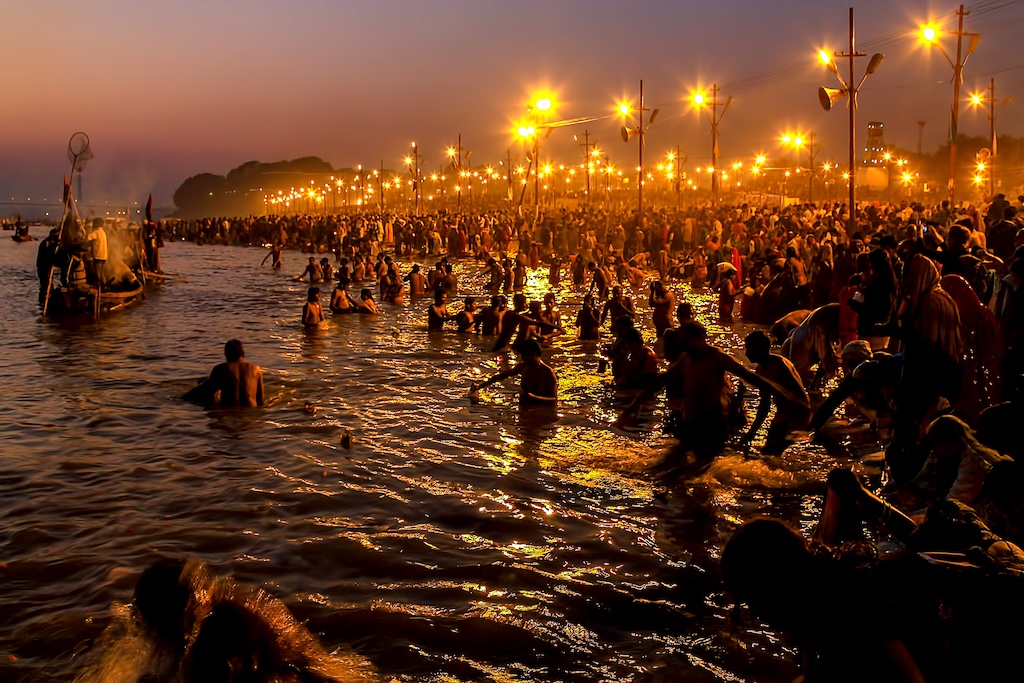Mahakumbh, also known as Kumbh Mela, is one of the most significant religious gatherings in Hinduism. It is held every twelve years in four sacred locations across India: Prayagraj (formerly Allahabad), Haridwar, Ujjain, and Nashik. The event attracts millions of devotees, saints, ascetics, and tourists from around the world, making it the largest peaceful congregation of people on Earth.
Historical Background
The origins of Mahakumbh are rooted in Hindu mythology. According to the legend, during the churning of the ocean (Samudra Manthan), a pot (Kumbh) of amrita (nectar of immortality) emerged. The gods and demons fought for the nectar, and during the battle, drops of amrita fell at four locations: Prayagraj, Haridwar, Ujjain, and Nashik. These places became the sacred sites where Kumbh Mela is celebrated.
Types of Kumbh Melas
There are four types of Kumbh Melas based on their frequency and significance:
- Mahakumbh Mela: Held every 12 years in Prayagraj.
- Purna Kumbh Mela: Held every 12 years but alternates among the four locations.
- Ardh Kumbh Mela: Held every six years in Haridwar and Prayagraj.
- Magh Mela (Mini Kumbh): Held annually in Prayagraj during the Hindu month of Magh (January-February).
Locations and Their Significance
Each of the four locations where Mahakumbh is held has its own spiritual importance:
- Prayagraj: Considered the most sacred, as it is the confluence (Sangam) of three rivers—Ganga, Yamuna, and the mythical Saraswati.
- Haridwar: Located on the banks of the Ganga, where the river descends from the Himalayas.
- Ujjain: Celebrated on the banks of the Kshipra River, associated with Lord Shiva and the temple of Mahakaleshwar.
- Nashik: Held on the banks of the Godavari River, linked to Lord Rama’s exile in Hindu mythology.
Rituals and Significance
Mahakumbh is marked by a series of rituals and traditions, the most significant of which is the Shahi Snan (royal bath). During this bath, millions of devotees and ascetics take a dip in the sacred rivers, believing that it cleanses them of sins and helps attain salvation (moksha).
Other key aspects include:
- Kalpavas: A period of strict asceticism and meditation undertaken by devotees along the riverbanks.
- Spiritual Discourses: Saints and scholars conduct discussions on Hindu scriptures, philosophy, and dharma.
- Akharas: Various sects of sadhus (ascetics), including Naga Sadhus (naked warriors), Udasin Akhara, and Vaishnav Akhara, participate in processions showcasing their spiritual might.
The Grand Procession of Sadhus
One of the most fascinating spectacles of Mahakumbh is the grand procession of sadhus, particularly the Naga Sadhus, who are known for their austerity and renunciation. They lead the royal bath, riding on elephants, horses, and chariots, chanting religious hymns and mantras. Their presence symbolizes the spiritual power of Hindu ascetics.
Cultural and Social Impact
Mahakumbh is not only a religious event but also a cultural and social phenomenon. It serves as a platform for:
- Religious Harmony: Various sects and traditions within Hinduism come together, promoting unity.
- Economic Boost: The event generates massive revenue through tourism, hospitality, and trade.
- Global Recognition: UNESCO has recognized Kumbh Mela as an Intangible Cultural Heritage of Humanity.
Management and Logistics
Organizing Mahakumbh is a colossal task requiring meticulous planning and execution. The government collaborates with religious organizations, NGOs, and local bodies to ensure:
- Security: Deployment of police, paramilitary forces, and disaster management teams.
- Infrastructure: Construction of temporary shelters, sanitation facilities, roads, and hospitals.
- Health and Hygiene: Free medical camps, vaccination drives, and water purification measures.
- Technology: Use of AI-based crowd management, drone surveillance, and digital platforms for real-time updates.
Global Participation
Mahakumbh attracts not just Indian pilgrims but also international visitors, including scholars, spiritual seekers, photographers, and media personnel. Many foreigners participate in the rituals, immersing themselves in the spiritual and cultural vibrancy of India.
Challenges and Environmental Concerns
Despite its grandeur, Mahakumbh poses challenges:
- Crowd Management: Ensuring safety and order in gatherings exceeding 100 million people.
- Environmental Issues: Managing waste, preventing river pollution, and maintaining ecological balance.
- Resource Allocation: Providing sufficient water, food, and medical aid to the masses.
To address these concerns, authorities emphasize sustainable practices such as eco-friendly waste disposal, awareness campaigns, and stricter pollution control measures.
Unfortunate Incident 2024
2025 Prayagraj Stampede: On January 29, 2025, a pre-dawn stampede occurred at the Maha Kumbh Mela in Prayagraj. At least 30 people were killed, and around 60 others were injured as pilgrims rushed towards the confluence of the Ganges, Yamuna, and Saraswati rivers for a ritual bath. Courtesy: bbc.com
Conclusion
Mahakumbh is a magnificent confluence of faith, tradition, and culture, symbolizing the essence of Hindu spirituality. It transcends religious boundaries, attracting seekers of wisdom and peace from across the globe. As the world’s largest religious gathering, Mahakumbh continues to be a testament to India’s rich spiritual heritage and its enduring belief in the power of faith and devotion.
Final Thoughts
Whether one is a devout Hindu or a curious traveller, experiencing Mahakumbh is a once-in-a-lifetime opportunity to witness the spiritual grandeur and cultural richness of India. It remains a beacon of religious harmony, self-purification, and collective devotion, reaffirming its status as the greatest festival on Earth.
Processing…
Success! You’re on the list.
Whoops! There was an error and we couldn’t process your subscription. Please reload the page and try again.

